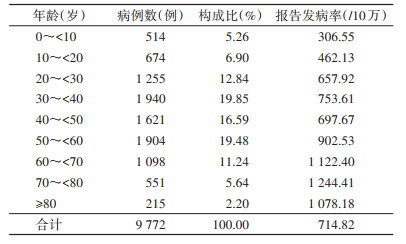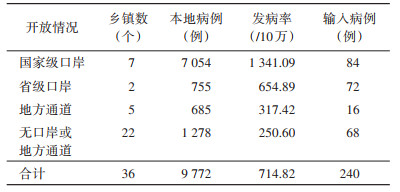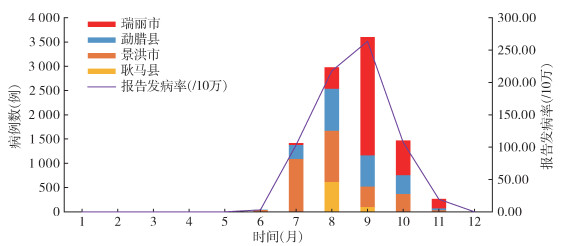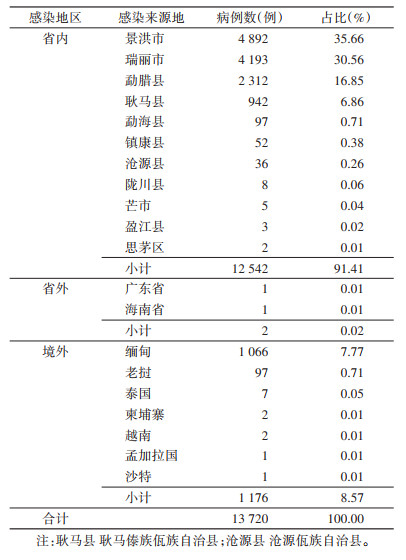扩展功能
文章信息
- 张荣兵, 段婧, 陈莉华, 郝林会, 田荣, 杨倩, 叶青
- ZHANG Rong-bing, DUAN Jing, CHEN Li-hua, HAO Lin-hui, TIAN Rong, YANG Qian, YE Qing
- 2023年云南省4个县(市)登革热暴发疫情特征分析
- An analysis of dengue fever outbreak characteristics in four cities/counties of Yunnan Province, China, 2023
- 中国媒介生物学及控制杂志, 2024, 35(5): 598-603
- Chin J Vector Biol & Control, 2024, 35(5): 598-603
- 10.11853/j.issn.1003.8280.2024.05.016
-
文章历史
- 收稿日期: 2024-03-15
2 昆明市疾病预防控制中心地方病与寄生虫病科, 云南 昆明 650228
2 Department of Endemic and Parasitic Diseases Prevention and Control, Kunming Center for Disease Prevention and Control, Kunming, Yunnan 650228, China
登革热是当前世界上流行范围较为广泛的一种蚊媒传染病,其暴发和流行给当地国家带来重大的经济和疾病负担[1-2],云南省位于中国西南边陲,与越南、缅甸、老挝等多国接壤,是“一带一路”向西南开放的“桥头堡”,随着商贸活动和对外交流的增加,跨境物流、人流交易日益频繁,云南省传染病跨境传播的风险持续存在[3],云南省长期面临输入登革热引起本地疫情暴发、流行的风险[4-5]。自2013年以来,云南省边境地区多次发生输入性登革热引起的区域性、大规模的本地疫情暴发,是云南省边境地区一个重要的公共卫生问题,本文通过对2023年云南省4个县(市)登革热暴发疫情特征进行分析,为边境地区登革热疫情防控提供参考。
1 材料与方法 1.1 资料来源病例信息和暴发疫情资料分别来源于“中国疾病预防控制信息系统”的“传染病监测”和“突发公共卫生事件管理信息系统”模块,按照报告地区和录入日期收集2023年云南省医疗卫生机构报告的所有登革热病例,耿马傣族佤族自治县、景洪市、瑞丽市、勐腊县人口数来源于各地区2023年国民经济和社会发展公报或各地区政府网站公开信息。
1.2 方法用Excel 2019软件对数据进行整理,感染来源地为传染病报告卡“备注栏”中备注的感染来源地信息。在对乡镇口岸级别进行分级时,将拥有国家级航空、港口、陆路交通枢纽的乡镇定义为国家级口岸地区;将拥有省级航空、港口、陆路交通枢纽的乡镇定义为省级口岸地区;地方通道地区定义为与周边国家存在边民通道的乡镇;无口岸或地方通道的乡镇为其他;如同时拥有口岸或通道则按最高口岸级别进行分析。
应用圆形分布法[6-7]分析登革热疫情暴发的时间节律特点,公式如下:X=∑ficosαi/∑fi,Y=∑fisinαi/∑fi,
用Excel 2019软件进行数据处理,MapInfo 7.8软件绘制疫情信息地图,数据采用SPSS 19.0软件分析,率或构成比采用χ2检验,两组非正态计量资料相关性采用Spearman秩相关检验,P < 0.05表示差异有统计学意义。定量资料不服从正态分布,采用中位数(M)描述。
2 结果 2.1 基本情况2023年,云南省共计报告登革热病例13 748例,年均报告发病率为29.42/10万,在感染来源地明确的13 720例病例中,本地病例占91.43%(12 542/13 720)、国内输入占0.02%(2/13 720)、境外输入占8.57%(1 176/13 720),本地病例涉及景洪市、瑞丽市、勐腊县、耿马傣族佤族自治县(耿马县)等11个县(市)。暴发疫情的瑞丽市、景洪市、勐腊县和耿马县共占全省报告登革热病例数的72.83%(10 012/13 748),其中瑞丽市、景洪市、勐腊县和耿马县各自报告3 864、3 045、2 298和805例,分别占全省报告病例数的28.11%、16.71%、22.15%和5.86%。见表 1。
4个县(市)报告的9 772例本地病例中,男性5 185例、女性4 587例,男女性别比为1.13∶1,报告发病率分别为714.00/10万、715.76/10万,男女报告发病率差异无统计学意义(χ2=0.015,P=0.903)。年龄分布上,20~ < 70岁人群占80.00%(7 818/9 772),最小年龄为0岁,最大为97岁,中位数为43岁,随年龄增加报告发病率有增加趋势(χ趋势2=985.310,P < 0.001),见表 2。在人群分布方面,在分类明确的8 945例(827例人群分类不详)病例中,报告病例数较多的前5位人群为农民、家务及待业、商业服务、自由职业、学生,构成比分别为31.25%(2 795/8 945)、16.88%(1 510/8 945)、14.21%(1 271/8 945)、10.90%(975/8 945)和8.09%(724/8 945)。

|
2023年4个县(市)本地病例暴发的报告时间范围为6-11月,按照圆形分布法对4个县(市)登革热暴发疫情的时间进行分析,报告高峰期时期为6月15日-11月11日,高峰时点为8月30日;4个县(市)输入病例、4个县(市)报告本地病例、4个县(市)感染向外输出病例时间分布基本一致,且不同月份3者间报告病例数有一定的相关性(rs输入-本地=0.901,P=0.006;rs本地-输出=0.893,P=0.007;rs输入-输出=0.793,P=0.033)。见表 3。

|
瑞丽市、景洪市、勐腊县和耿马县分别报告本地病例3 824、2 996、2 224和728例。报告本地病例较多的乡镇为瑞丽市勐卯镇,景洪市允景洪镇、嘎洒镇和勐龙镇,勐腊县勐腊镇、磨憨镇、勐捧镇和勐仑镇以及耿马县孟定镇。4个县(市)病例分布呈现以口岸或城区聚集性为主,边界地区多发,内陆郊区乡镇多为散发的态势。瑞丽市和耿马县病例主要集中在口岸乡镇孟定镇和勐卯镇,其他乡镇主要为散发态势;景洪市、勐腊县呈现出以城区和口岸为主、多点输入、多点暴发的态势。见图 1。

|
| 注:耿马县耿马傣族佤族自治县。 图 1 2023年云南省4个县(市)登革热暴发疫情地区分布 Figure 1 Regional distribution of dengue fever cases in four cities/counties of Yunnan Province, 2023 |
| |
以向云南省其他县(市)区输出的登革热病例数占某县(市)区感染病例数的百分比计算溢出比例。感染来源地为4个县(市)的病例占全省病例的89.93%(12 339/13 720),其中4个县(市)报告本土病例9 772例,向省内其他地区[包括4个县(市)内部相互输出]输出病例2 567例,溢出比例为20.80%(2 567/12 339),其中瑞丽市、景洪市、勐腊县和耿马县溢出比例分别为8.80%(369/4 193)、38.76%(1 896/4 892)、3.81%(88/2 312)和22.72%(214/942)。
2.3 不同级别口岸乡镇的登革热聚集性分析在各级口岸中,国家级口岸对应乡镇报告本地比例最多,为7 054例,发病率为1 341.09/10万,报告发病率最低的为无口岸或地方通道的地区,为250.60/10万报告1 278例。随着开放水平的降低,各乡镇报告的本地病例发病率之间有降低趋势(χ趋势2=4 610.937,P < 0.001)。见表 4。

|
根据2019-2023年4个县(市)暴发疫情媒介监测信息显示,埃及伊蚊(Aedes aegypti)为主要优势种,其次为白纹伊蚊(Ae. albopictus),布雷图指数1-5月较低,6月开始上升,7-9月为高峰期,10月开始逐渐下降。不同月份报告本地病例数见图 2。

|
| 图 2 2023年云南省4个县(市)登革热暴发疫情时间分布 Figure 2 Reported incidence of dengue fever in 4 counties (cities) of Yunnan Province in 2023 |
| |
4个县(市)登革热病例主要集中于人口密度大、流动人口多的口岸或城区,各乡镇报告发病率与当地人口密度有一定的正相关关系(rs=0.446,P=0.006)。
3 讨论云南省与缅甸、老挝和越南交界,口岸、通道较多。与周边国家商贸、人文交流频繁,地理、气候环境相似,蚊媒种类相近、带病毒率高,为蚊媒传染病在云南省与相邻国家间的传播创造了条件[3-4, 8]。输入性登革热是引起本地疫情发生的主要原因,随着气候变化、全球化进程和“一带一路”倡议实施的不断推进,将会促进更多的地区适合媒介伊蚊和登革病毒不断扩散和传播,未来云南省登革热疫情防控形势将更加严峻[4, 9]。边境地区在流行季节要及时进行监测预警和风险评估,关口前移,提前做好以环境卫生治理为重点的媒介生物控制工作,确实做好入境人员的检测和输入病例的管理,科学、规范开展早期疫情处置,防止境外输入再传播。
高发区(口岸/城区)主要以社区传播为主,该地区人口密度大、外来人员多、商业服务仍然是登革热疫情向各行业渗透传播的重要途径,应及时掌握当地人口密度、人口流动情况等,加强登革热病例的管理和流动人员的监测工作[10];同时,4个县(市)病例就诊后流动性大,传染源管理困难,造成多点暴发的可能性增加,应在做好病例隔离治疗的基础上,加强疫点的病例搜索工作。同时严格落实传染病防控“政府、部门、单位和个人”四方责任,广泛开展社区健康教育、充分发动群众消除蚊媒孳生地,大范围内开展以环境整治、快速杀灭成蚊和清除室内外及公共场所等伊蚊孳生环境为主的综合防制措施,大力开展媒介监测,保证监测覆盖面,加强督导,提高监测质量,尽快阻断伊蚊传播登革热的能力,防止社区疫情的扩散和蔓延[11-12],其他地区应关注输入性疫情引起的局部地区暴发现象。
边境口岸(通道)是当地与外地沟通交流的重要桥梁和通道,会引起媒介和传染源的快速扩散,对其他地区的登革热防控工作带来重大挑战,应以边境州(市)口岸地区为重点,加大对该地区基层医疗机构登革热培训,做到早发现、早诊断、早治疗、就地治疗,高龄人群作为登革热高危人群应引起特别重视[13]。同时需加强本土病例的监测和管理,通过健康教育等提高居民健康素养和防病意识[14-15],以减少媒介和传染源向内陆地区的远距离输送和对内陆地区其他人群的影响。
4个县(市)疫情呈现多点输入、多点暴发、由边境口岸(通道)乡镇向周围乡镇及内陆扩散的态势。该地区外来人员较多,病例管理困难并不断向省内其他地区溢出,随着气候变暖、人流和物流的不断增加,云南省登革热的防控形势将更趋严峻。从源头上做好4县(市)登革热防控和防止疫情外溢,可以从提前做好以环境卫生治理、健康教育为重点的媒介生物控制,输入性病例的管理工作,早期疫情和媒介监测、媒介生物控制、疫点的规范化处置[16-17],本土病例管理以及流动人口监测等方面予以探索。
志谢 云南省各县(市)疾病预防控制中心及时上报核实登革热疫情,特此志谢利益冲突 无
| [1] |
Hung TM, Clapham HE, Bettis AA, et al. The estimates of the health and economic burden of dengue in Vietnam[J]. Trends Parasitol, 2018, 34(10): 904-918. DOI:10.1016/j.pt.2018.07.007 |
| [2] |
Shepard DS, Coudeville L, Halasa YA, et al. Economic impact of dengue illness in the Americas[J]. Am J Trop Med Hyg, 2011, 84(2): 200-207. DOI:10.4269/ajtmh.2011.10-0503 |
| [3] |
王荣华, 彭霞, 贾豫晨, 等. 云南省边境地区传染病跨境传播防控现状调查[J]. 中国国境卫生检疫杂志, 2019, 42(1): 25-28. Wang RH, Peng X, Jia YC, et al. Investigation on the surveillance and prevention of infectious diseases cross-border spread inYunnan[J]. Chin J Front Health Quarant, 2019, 42(1): 25-28. DOI:10.16408/j.1004-9770.2019.01.007 |
| [4] |
张荣兵, 洪劲, 田荣, 等. 2015-2021年云南省境外输入登革热和疟疾病例特征分析[J]. 预防医学, 2023, 35(2): 141-143. Zhang RB, Hong J, Tian R, et al. Epidemiological characteristics of overseas imported dengue fever and malaria cases in Yunnan Province from 2015 to 2021[J]. Prev Med, 2023, 35(2): 141-143. DOI:10.19485/j.cnki.issn2096-5087.2023.02.012 |
| [5] |
孟凤霞, 王义冠, 冯磊, 等. 我国登革热疫情防控与媒介伊蚊的综合治理[J]. 中国媒介生物学及控制杂志, 2015, 26(1): 4-10. Meng FX, Wang YG, Feng L, et al. Review on dengue prevention and control and integrated mosquito management in China[J]. Chin J Vector Biol Control, 2015, 26(1): 4-10. DOI:10.11853/j.issn.1003.4692.2015.01.002 |
| [6] |
曹君, 苑思博, 何国鹏, 等. 圆形分布法探讨2019-2021年广州市南沙区心脑血管疾病死亡时间的聚集性[J]. 中国卫生统计, 2022, 39(6): 871-872, 877. Cao J, Yuan SB, He GP, et al. Discussion on the clustering of death time of cardiovascular and cerebrovascular diseases in Nansha District of Guangzhou from 2019 to 2021 by circular distribution method[J]. Chin J Health Statist, 2022, 39(6): 871-872, 877. DOI:10.3969/j.issn.1002-3674.2022.06.016 |
| [7] |
王同瑜, 郭云昌, 吴阳博, 等. 基于圆形分布法的中国大陆食源性致泻大肠埃希氏菌暴发事件时间分布特征分析[J]. 中国食品卫生杂志, 2022, 34(5): 1048-1053. Wang TY, Guo YC, Wu YB, et al. Analysis of seasonal characteristics of foodborne diarrheagenic Escherichia coli outbreaks based on circular distribution method in China's mainland[J]. Chin J Food Hyg, 2022, 34(5): 1048-1053. DOI:10.13590/j.cjfh.2022.05.029 |
| [8] |
高玉峰, 程晓兰, 丁晔, 等. 中国西南边境地区蚊类携带病原体调查[J]. 中国国境卫生检疫杂志, 2020, 43(2): 91-94. Gao YF, Cheng XL, Ding Y, et al. Investigation on mosquito-borne pathogens in the southwest border areas, China[J]. Chin J Front Health Quarant, 2020, 43(2): 91-94. DOI:10.16408/j.1004-9770.2020.02.004 |
| [9] |
魏春, 郭小连, 杨锐, 等. 云南省2013-2020年登革热流行及聚集特征分析[J]. 中国媒介生物学及控制杂志, 2021, 32(6): 720-724, 743. Wei C, Guo XL, Yang R, et al. Epidemiological and cluster characteristics of dengue fever in Yunnan Province, China, 2013-2020[J]. Chin J Vector Biol Control, 2021, 32(6): 720-724, 743. DOI:10.11853/j.issn.1003.8280.2021.06.013 |
| [10] |
陈莉华, 念鹏英, 沈秀莲, 等. 云南省2013-2022年登革热流行趋势及暴发疫情特征分析[J]. 中国媒介生物学及控制杂志, 2024, 35(1): 63-68, 73. Chen LH, Nian PY, Shen XL, et al. Epidemiological trends and outbreak characteristics of dengue fever in Yunnan Province, China, 2013-2022[J]. Chin J Vector Biol Control, 2024, 35(1): 63-68, 73. DOI:10.11853/j.issn.1003.8280.2024.01.011 |
| [11] |
伦辛畅, 杨锐, 吴海霞, 等. 2005-2019年云南省缅甸登革热输入病例流行特征分析[J]. 中国媒介生物学及控制杂志, 2022, 33(1): 108-113. Lun XC, Yang R, Wu HX, et al. An analysis of epidemiological characteristics of imported dengue fever cases from Myanmar in Yunnan Province, China, 2005-2019[J]. Chin J Vector Biol Control, 2022, 33(1): 108-113. DOI:10.11853/j.issn.1003.8280.2022.01.020 |
| [12] |
丰俊, 张丽, 涂宏, 等. 从消除到消除后: 中国输入性疟疾的疫情特征、挑战及防止再传播策略[J]. 中国热带医学, 2021, 21(1): 5-10. Feng J, Zhang L, Tu H, et al. From elimination to post-elimination: Characteristics, challenges and re-transmission preventing strategy of imported malaria in China[J]. China Trop Med, 2021, 21(1): 5-10. DOI:10.13604/j.cnki.46-1064/r.2021.01.02 |
| [13] |
中华医学会感染病学分会, 中华医学会热带病与寄生虫学分会, 中华中医药学会急诊分会. 中国登革热临床诊断和治疗指南[J]. 传染病信息, 2018, 31(5): 385-392. Chinese Society of Infectious Diseases of the Chinese Medical Association, Chinese Society of Tropical Medicine and Parasitology of the Chinese Medical Association, Emergency Branch of the Chinese Association of Chinese Medicine. Clinical diagnosis and treatment guidelines for dengue fever in China[J]. Infect Dis Inf, 2018, 31(5): 385-392. DOI:10.3969/j.issn.1007-8134.2018.05.001 |
| [14] |
张晓檀, 孟波林. 出入境人员传染病检测结果分析及新形势下卫生检疫应对策略研究[J]. 质量安全与检验检测, 2020, 30(5): 113-114, 119. Zhang XT, Meng BL. Analysis of infectious diseases detection results of entry-exit personnel and study on health quarantine countermeasures under the new situation[J]. Qual Saf Inspect Test, 2020, 30(5): 113-114, 119. |
| [15] |
张森乔, 常璞, 马小婷, 等. "一带一路"沿线国家出入中国国境人员传染病监测结果回顾分析[J]. 中国国境卫生检疫杂志, 2021, 44(4): 275-279. Zhang SQ, Chang P, Ma XT, et al. Retrospective analysis of infectious disease surveillance among people entering and leaving China from the countries along "one Belt and one Road"[J]. Chin J Front Health Quarant, 2021, 44(4): 275-279. DOI:10.16408/j.1004-9770.2021.04.012 |
| [16] |
林祖锐, 张豪, 孙晓东, 等. 2016-2018年云南省疟疾个案和疫点调查处置情况[J]. 中国人兽共患病学报, 2021, 37(6): 525-531. Lin ZR, Zhang H, Sun XD, et al. Malaria cases and the reactive response in Yunnan Province from 2016 to 2018[J]. Chin J Zoonoses, 2021, 37(6): 525-531. DOI:10.3969/J.issn.1002-2694.2021.00.016 |
| [17] |
刘慧, 许建卫, 夏敏, 等. 跨中缅泰的三种民族社区登革热暴发疫点处置和防控定性比较研究[J]. 中国热带医学, 2019, 19(11): 1034-1038. Liu H, Xu JW, Xia M, et al. Comparatively qualitative study of responses to dengue fever foci in communities of three ethnical minorities crossing China-Myanmar-Thailand borders[J]. China Trop Med, 2019, 19(11): 1034-1038. DOI:10.13604/j.cnki.46-1064/r.2019.11.07 |
 2024, Vol. 35
2024, Vol. 35



